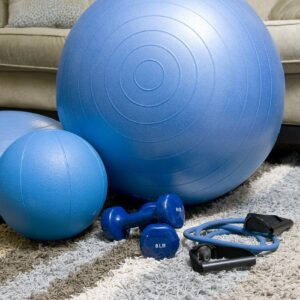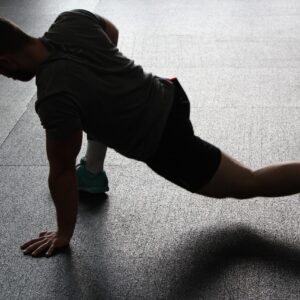Ready to achieve your fitness goals without leaving the comfort of your own home? Look no further than home workout schedules! These cleverly designed schedules provide a convenient and effective way to stay active and fit, no matter your busy lifestyle. From strength-training exercises to cardio routines, these schedules offer a variety of workouts that can be easily followed right from your living room. Whether you’re a beginner or an experienced fitness enthusiast, these home workout schedules will help you stay motivated, track your progress, and ultimately reach your fitness goals in a fun and engaging way. Say goodbye to expensive gym memberships and hello to a healthier, happier you with home workout schedules!
Benefits of Home Workouts
Convenience
One of the biggest advantages of home workouts is the convenience they offer. With a home workout routine, you have the flexibility to exercise at any time that suits you best. You no longer have to worry about rushing to the gym after work or squeezing in a workout before it closes. By working out at home, you eliminate the time spent on commuting and waiting for equipment, making your fitness routine much more efficient.
Cost-effective
Home workouts can save you a considerable amount of money in the long run. Gym memberships can be expensive, and even though they offer various amenities, many individuals only utilize a portion of what is available. By investing in a few essential workout tools, such as resistance bands or dumbbells, you can create an effective exercise routine without breaking the bank. Moreover, you don’t have to worry about additional costs like transportation expenses or the need for trendy workout gear.
Time-saving
With a busy lifestyle, finding time to exercise can be challenging. However, home workouts can help you save precious time. By eliminating the need to travel to a gym, you can start your workout immediately and utilize the time you would have spent commuting for other activities. Additionally, home workouts allow you to customize the duration of your exercise sessions according to your schedule. Whether you have ten minutes or an hour, you can fit in a quick workout without any time constraints.
Privacy
For some individuals, performing exercises in a public setting can be uncomfortable or intimidating. With home workouts, privacy is guaranteed. You can exercise in the comfort of your own space without the fear of being judged or feeling self-conscious. This sense of privacy can boost your confidence and encourage you to push yourself during workouts. Whether you want to try new exercises or experiment with different routines, the privacy of your home allows you to do it all without any reservations.
Setting Realistic Fitness Goals
Identifying your fitness goals
Before starting any fitness journey, it is crucial to identify your specific goals. Whether you want to lose weight, build muscle, improve flexibility, or enhance overall fitness, understanding your objectives enables you to create a tailored workout routine. Take some time to reflect on what you hope to achieve and write down your goals so you can refer back to them throughout your fitness journey.
Making them SMART
Once you have identified your fitness goals, it is essential to make them SMART: Specific, Measurable, Attainable, Relevant, and Time-bound. Specific goals are clear and well-defined, allowing you to focus your efforts more effectively. Measurable goals enable you to track your progress and celebrate milestones along the way. Attainable goals should be challenging yet realistic, ensuring that you stay motivated. Relevant goals align with your overall fitness objectives. Time-bound goals have a specific deadline, providing a sense of urgency and accountability.
Breaking down goals into smaller milestones
Breaking down your fitness goals into smaller milestones can make them more achievable and manageable. Rather than being overwhelmed by the magnitude of your goals, breaking them down into smaller, more digestible steps allows you to make steady progress. Celebrate each milestone as a victory, which will keep you motivated and encouraged to continue on your fitness journey.
Creating a Home Workout Schedule
Determining the frequency and duration of workouts
When creating a home workout schedule, it is important to consider the frequency and duration of your workouts. Aim for consistency by scheduling regular workout sessions throughout the week. The number of days you allocate for exercise should depend on your current fitness level and availability. Additionally, determine the optimal length of each workout session that fits into your daily routine. This will vary depending on your goals and personal preferences, but starting with shorter sessions and gradually increasing the duration can be a good approach.
Choosing the right exercises
Selecting the right exercises for your home workout routine is essential to target different muscle groups and ensure a well-rounded fitness program. Incorporate exercises that focus on cardiovascular health, strength training, flexibility, and balance. A combination of exercises such as squats, lunges, push-ups, planks, and yoga poses can be effective in providing a comprehensive workout experience. Consider your fitness goals and consult resources such as online workout videos or fitness apps to create a diverse and engaging routine.
Mixing cardio and strength training
To maximize the benefits of your home workout routine, it is important to incorporate both cardiovascular exercises and strength training. Cardio exercises, such as jogging in place, jumping jacks, or high-intensity interval training (HIIT), help improve heart health, burn calories, and increase endurance. On the other hand, strength training exercises, like bodyweight exercises or resistance training, help build muscle, increase metabolism, and improve overall strength. Balancing both types of exercises ensures a well-rounded fitness routine.
Including rest days
Rest days are just as important as workout days when creating a home workout schedule. Your body needs time to recover and repair itself after intense physical activity. Schedule at least one or two rest days throughout the week to allow your muscles time to rest and rebuild. On these days, focus on engaging in relaxing activities, stretching, or recovery exercises such as yoga or foam rolling. Rest days contribute to injury prevention and overall improvement in performance.

Planning Your Workout Routine
Warm-up exercises
Before diving into your main workout, it is crucial to warm up properly. Warm-up exercises increase blood flow and prepare your muscles, joints, and cardiovascular system for the upcoming physical activity. Consider incorporating dynamic stretches, light cardio exercises, or mobility drills to gradually increase your heart rate and warm up your muscles. Warm-up routines can help reduce the risk of injury and enhance your overall performance during the workout.
Target specific muscle groups
To achieve a well-rounded fitness routine, it is important to target specific muscle groups during your workouts. Whether you want to focus on strength, endurance, or toning, make sure to include exercises that target different areas of the body. For example, if you want to work on your upper body strength, incorporate exercises like push-ups, tricep dips, or bicep curls. For lower body strength, exercises like squats, lunges, or deadlifts can be beneficial. By targeting specific muscle groups, you can create a balanced workout routine.
Variety in exercises
Repetitive workout routines can lead to boredom and plateau. To keep your home workouts engaging, it is important to incorporate variety in your exercises. Try new exercises, experiment with different workout styles, or switch up the order of your routine from time to time. This not only helps prevent boredom but also challenges your body in new ways, leading to continued progress and results. Consider incorporating different exercise modalities like bodyweight exercises, resistance training, yoga, or dance workouts to keep your routine fresh and exciting.
Cool-down and stretching
Just as warming up is crucial, cooling down and stretching at the end of your workout is equally important. This helps your body gradually transition from exercise to a resting state, reducing muscle soreness and promoting flexibility. Incorporate static stretches targeting major muscle groups or use foam rollers to release any tension. Cooling down also allows your heart rate to gradually return to its normal state and helps prevent dizziness or lightheadedness after intense physical activity.
Utilizing Home Workout Resources
Online workout videos and apps
One of the great advantages of home workouts is the availability of online workout videos and fitness apps. There are numerous platforms that offer a wide range of workout options, from high-intensity interval training to yoga and Pilates classes. These resources provide step-by-step guidance, enabling you to follow along with professional instructors in the comfort of your own home. Whether you prefer structured workouts or personalized routines, online videos and apps offer a wealth of options to cater to your fitness preferences and goals.
Fitness equipment and tools
While it is possible to have effective home workouts with minimal equipment, incorporating fitness tools and equipment can enhance your routine. Depending on your goals and preferences, consider investing in items such as resistance bands, dumbbells, stability balls, or yoga mats. These tools can add variety and challenge to your workouts, increasing the intensity or targeting specific muscle groups. Be sure to research proper usage and techniques to get the most out of any equipment you purchase.
Home workout classes or personal trainers
If you are looking for more personalized guidance and support, home workout classes or personal trainers can be valuable resources. Many fitness professionals offer virtual classes or one-on-one training sessions that can be accessed from home. These professionals can provide expert advice, create customized workout routines, and offer real-time feedback to ensure you are performing exercises correctly and efficiently. Consider your budget and preferences when deciding to hire a trainer or join virtual classes to find the option that best fits your needs.
Fitness communities and forums
Connecting with like-minded individuals can provide additional motivation and support for your fitness journey. Online fitness communities and forums allow you to interact and seek advice from individuals who share similar goals and challenges. These communities offer a platform to ask questions, share achievements, and find support during times when your motivation may be wavering. Engaging with fellow fitness enthusiasts can help you stay accountable and provide valuable insights into maintaining a successful home workout routine.
Maintaining Motivation and Consistency
Find an accountability partner
Staying motivated when working out at home can sometimes be challenging. However, finding an accountability partner can greatly enhance your commitment to your fitness goals. This can be a friend, family member, or colleague with similar fitness aspirations. Plan workout sessions together, check in with each other, and hold each other accountable. Sharing successes, challenges, and progress can keep you motivated and make the journey more enjoyable.
Track your progress
Tracking your progress is an essential motivator on your fitness journey. Keep a record of your workouts, including the type of exercises, duration, and intensity. Additionally, take measurements of your body, such as weight, body fat percentage, or inches lost/gained, to monitor changes over time. This tangible evidence of progress can serve as a reminder of your hard work and dedication, motivating you to continue pushing forward towards your goals.
Reward yourself for milestones
Reaching milestones along your fitness journey is an accomplishment worth celebrating. Rewarding yourself for achieving specific goals can provide a sense of achievement and satisfaction. Treat yourself to a small reward, such as a massage, a new workout outfit, or a day of relaxation. These rewards act as incentives, keeping you motivated and eager to work towards your next milestone.
Mix up your workouts
Monotonous routines can lead to boredom and a lack of motivation. To keep your excitement and interest levels high, mix up your workouts regularly. Try new exercises, explore different workout styles, or engage in outdoor activities to add variety to your routine. This not only keeps your body guessing and prevents plateaus but also keeps your mind engaged and motivated to continue challenging yourself.
Overcoming Challenges and Obstacles
Dealing with distractions at home
Working out at home comes with its own set of distractions. The proximity of household chores, family members, or electronic devices can make it difficult to stay focused during your workouts. To overcome these challenges, create a dedicated workout space that is free from distractions. Set clear boundaries with yourself and others, communicate your workout schedule, and ensure that you can dedicate uninterrupted time to your exercise sessions.
Adapting to limited space or equipment
Limited space or lack of equipment can pose challenges when exercising at home. However, with some creativity, you can adapt your workouts to fit your constraints. Utilize bodyweight exercises that require minimal space and equipment, such as planks, burpees, or jumping jacks. Make use of household items like sturdy furniture or water bottles as makeshift weights. Additionally, explore online resources for home workouts specifically designed for small spaces or limited equipment availability.
Managing time effectively
Time management is crucial when it comes to maintaining a consistent home workout routine. Plan your workouts in advance and schedule them into your daily or weekly calendar. Treat your workout like any other important appointment or commitment and prioritize it. Additionally, consider shorter, high-intensity workouts if you are short on time. Making exercise a non-negotiable part of your schedule will help you stay committed and ensure that you make time for your health and well-being.
Staying motivated without a gym environment
The absence of a gym atmosphere can sometimes affect motivation levels. However, there are creative ways to stay motivated without a traditional gym environment. Set the mood by creating a workout playlist or listening to motivational podcasts during your sessions. Use visual reminders, such as motivational quotes or images, to inspire and uplift you during workouts. Create a dedicated workout space that is inviting and visually appealing. Experiment with different workout styles and exercises to keep your routine fresh and exciting.
Incorporating Proper Nutrition
Balanced and nutritious meals
Physical activity alone is not enough to achieve your fitness goals. Proper nutrition plays a crucial role in supporting your workouts and overall well-being. Aim for a balanced diet that includes protein, carbohydrates, healthy fats, vitamins, and minerals. Incorporate whole foods like fruits, vegetables, lean proteins, whole grains, and healthy fats into your meals. Be mindful of portion sizes and avoid excessive intake of processed or sugary foods. Consulting a dietitian or nutritionist can provide personalized guidance on your specific dietary needs.
Pre- and post-workout snacks
Fueling your body before and after workouts is important for energy levels and muscle recovery. Consume a small snack containing a combination of carbohydrates and protein before your workout to provide energy and prevent fatigue. Opt for options such as a banana with peanut butter or Greek yogurt with berries. After your workout, have a protein-rich snack to aid in muscle repair and recovery. Some examples include a protein shake, a chicken breast, or a handful of nuts.
Hydration
Proper hydration is often overlooked but is vital for optimal performance during workouts. Drink water before, during, and after your exercise sessions to replenish fluids lost through sweat. The amount of water you need may vary depending on factors such as climate, intensity of exercise, and individual metabolism. Pay attention to your body’s signals of thirst and aim for clear or light yellow urine as an indication of proper hydration.
Consulting a dietitian or nutritionist
When it comes to nutrition, seeking advice from a professional can be highly beneficial. A dietitian or nutritionist can provide personalized guidance tailored to your specific needs and goals. They can help you create a nutrition plan that complements your home workout routine, optimize your intake of essential nutrients, and address any dietary concerns or restrictions you may have. Consulting a professional ensures that you receive accurate and reliable information to support your fitness journey.
Safety and Injury Prevention
Proper form and technique
Maintaining proper form and technique during exercises is crucial to prevent injuries and get the most out of your workouts. Poor form can lead to strains, sprains, or joint pain. Focus on understanding the correct form for each exercise and ensure you are performing the movements correctly. Utilize online resources, virtual classes, or seek guidance from a fitness professional to learn proper form. Start with lighter weights or modified versions of exercises to build strength and gradually progress.
Gradually increasing intensity
To avoid overexertion and reduce the risk of injuries, it is important to gradually increase the intensity of your workouts. Pushing yourself too hard too soon can lead to burnout or muscle fatigue. Gradually increase the weight, duration, or intensity of your exercises over time. Listen to your body and pay attention to any signs of pain or discomfort. Building a solid foundation and gradually progressing ensures a safe and sustainable fitness journey.
Listening to your body
Your body is an excellent indicator of its own limits and needs. Pay attention to any sensations of pain, discomfort, or excessive fatigue during your workouts. If something feels off, adjust or modify the exercise accordingly. Rest when needed and give your body time to recover. Overtraining or ignoring signs of pain can lead to more serious injuries or setbacks in your fitness journey. Prioritize your safety and well-being above all else.
Seeking professional help for injuries
Despite taking precautions, injuries can still occur. If you experience an injury during your home workout, it is important to take it seriously and seek professional help if needed. Consult a healthcare professional, such as a physical therapist or sports medicine specialist, for proper diagnosis and treatment. They can provide guidance on recovery and rehabilitation exercises, ensuring a safe return to your home workout routine.
Evaluating and Adjusting Your Home Workout Schedule
Assessing progress towards goals
Regularly assessing your progress is important to determine if your current home workout schedule is effective and aligned with your goals. Revisit your initial fitness goals and evaluate if you are making progress. Take measurements, track changes in strength or endurance, and reflect on how you feel physically and mentally. If you are not seeing the desired results, it may be time to make adjustments to your routine.
Modifying workout duration and intensity
Based on your progress and comfort level, consider modifying the duration and intensity of your workouts. If you find that your routine is no longer challenging, increase the intensity by adding more resistance, increasing weights, or trying advanced variations of exercises. On the other hand, if you notice excessive fatigue or lack of progress, it may be an indication to decrease intensity or incorporate more rest days. Listen to your body and make adjustments accordingly to ensure ongoing progress.
Experimenting with new exercises
Keeping your workouts fresh and exciting is crucial for continued motivation. Consider experimenting with new exercises or workout styles to challenge your body in different ways. Explore online resources, workout apps, or fitness communities for inspiration. Trying new exercises not only keeps your routine interesting but also allows you to target different muscle groups and break through plateaus. Incorporate workouts that align with your goals while introducing variety into your fitness regimen.
Revisiting and updating goals
Just as it is important to set realistic fitness goals, it is equally important to periodically revisit and update them. As you progress in your fitness journey, your goals may evolve or change. Take the time to reflect on your accomplishments and set new targets that excite and challenge you. By revisiting and updating your goals, you ensure that your home workout schedule remains aligned with your aspirations and continues to drive your progress.
Incorporating home workouts into your fitness routine offers numerous benefits such as convenience, cost-effectiveness, and privacy. By setting realistic fitness goals, creating a home workout schedule, planning your routine, utilizing resources, and maintaining motivation, you can achieve great results from the comfort of your own home. Overcoming challenges, incorporating proper nutrition, prioritizing safety, and regularly evaluating and adjusting your schedule ensures a sustainable and successful fitness journey. So, lace up those sneakers, create your home workout space, and embark on a rewarding and transformative path towards better health and fitness.




